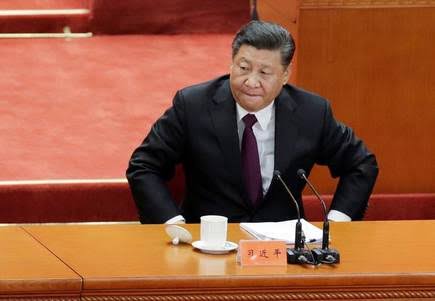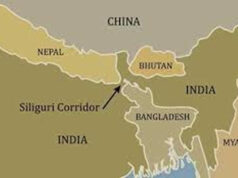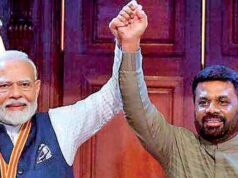China should learn to work cooperatively with India to Usher in Asia’s century

By
Colonel Awadhesh Kumar, Special Forces
China has become the Second largest economy in the World and India is presently the third largest economy in PPP terms (actual indicator of an economy).
In the first nine months of India’s fiscal year from April to December 2020, India exported Rs 114750 Crores of goods to China while importing Rs 349500 crores from China. However these were items already in the pipeline.
After Chinese PLA attacked the Indian Army in Galwan, things have changed. Now Chinese traders are finding it very difficult to lure the Indians with their cheap goods. The above numbers have already started changing as India is becoming more ATMANIRBHAR day by day. India has also started attracting substantial International investment which will be a big help in further transforming its economy by exploring new avenues through trade and investment with various countries.
In the post-lockdown period, India has already won most of Africa, Asia and South America with its gifting of indigenous Covid Vaccine. This is the Hard reality that china which is perceived to have exported the Wuhan Virus to the World cannot dodge when making it’s diplomatic and trade policies.
Appreciation of Indian gesture by the world will soon turn into high regards for Indian scientific and technological prowess too. Most of these countries will now be looking for stronger trade, Commerce and even military ties with India. Beijing already struggling with its own governance woes in Hong Kong, Xinjiang and few other parts of China, just cannot afford to ignore the Indian progress. It is hoped that China’s policy to hobble Indian progress through Pakistan and pressure on Indo Tibetan Border and LAC on Chinese occupied Indian territory in Ladakh comes to a halt immediately. It should not be lost in the so-called “patriotic” sentiments incited by some in the Chinese Military Commission that will only beleaguer its economy and, of course, its foreign policy should not be kidnapped by the Chinese Communist Party hardliners.
In the current era, Sino-India relations are now at a new crossroads. Maintaining solid friendship serves best the fundamental interests between the two largest developing Asian giants which is essential for making this century the “Asian Century”. The Sino-India friendship should not stagnate due to the difficulty posed by Ladakh and Tibetan issues. The two countries can move along to improve bilateral ties. Only with improved ties can the world’s two most populous and economically strong countries shoulder the responsibility of maintaining global stability.
Mistrust must vanish between the two countries and as friends and partners both should work cooperatively on various projects to improve Sino-India relations.
The Chinese State Councilor and Foreign Minister Wang Yi stated positively last week on the mending of the Sino-India relationship which has been uneasy following the tense border skirmishes along the Line of Actual Control (LAC) in Ladakh region last year.
Though the virtual media conference fielded questions on the US-China relationship in post-Trump era, China-Russia bilateral relations, COVID-19 vaccine cooperation, Hong Kong electoral system, global governance, the Belt and Road Initiative and some major domestic events to be held this year, Wang also spoke at length about the importance of building a “constructive relationship” with India. He offered a fresh blueprint to clear the air on Sino-Indian bilateral relations after the prolonged border standoff in the Ladakh on the LAC.
The foreign minister exhibited both hope and confidence on relations between Asia’s two biggest countries. “The boundary dispute, an issue left from history, is not the whole story of the China-India relationship,” Wang said. The candid tone of his remarks emphasized that China values its friendship with India and will work to manage its differences with its neighbor.
Calling the boundary dispute as not the “whole story” of the Sino-Indian relationship, he said that China and India are each other’s friends and partners, not threats or rivals, so the two sides need to help rather than undercutting each other and intensify cooperation rather than harboring suspicions. Surely, the points he made hold much significance to have a strong relationship, as long as both sides strive to build trust instead of fighting each other.
Now China has been using This Rhetoric tactics for long. To show that it genuinely wants friendship, it must first vacate entire occupied Ladakh. Thereafter the Indo Tibetan birder must be demarcated physically on the ground. Finally should be discussed the restoration of freedom to the people of Tibet by removal of the Chinese yoke.
Once above steps are taken by China then India Too will consider removal of actions such as imposing a range of economic measures against Chinese firms and apps as well as tightening the curbs on Chinese investment in India. This way the two countries together can bring greater benefits to the 2.7 billion people in China and India, and make greater contributions to the beginning of the “Asian Century”.
In terms of their growing power and economic influence, Sino-Indian ties may indeed be the most influential relationship of the 21st century. As such, the need of the hour is that, the two countries should significantly expand spheres of economic-trade relations, mutual trust, people-to-people friendship in order to bring back bilateral relations to the right track of healthy and steady growth for the “historic mission” of bettering lives for the two peoples.
Fortunately, the months-long border crisis came to end as the two Asian giants agreed to disengage their troops from LAC in Ladakh after the several rounds of diplomatic and military talks between the two sides. Accordingly, the disengagement process which began on both Northern and Southern banks of Pangong Tso lake on February 11 completed on February 19 followed by the tenth round of Corps Commander level talks between two armies in the Chinese occupied side of Moldo across Chushul on February 20 which had “candid and in-depth exchange of views on the remaining issues along the LAC in the western sector” as per the words of India’s external affairs ministry spokesperson Anurag Srivastava. The Pangong disengagement suggests that both sides are now willing to create a positive trend for better bilateral ties that have been affected and disrupted by the LAC conflict in the past year.
However, although many China-experts and some in the opposition party included, echoed their skepticism on the efficacy of the disengagement agreement by stating how much India has compromised for peace with China,. It is unrealistic to expect a permanent solution to the sticky LAC issue in the near future, so peaceful negotiations must be carried on. Only this will maintain peace along the 3,488-km-long Indo Tibetan Border. It is seen that after the the military disengagement in Ladakh, the two countries also made a move on the political front. A dialogue over phone was led by Indian Foreign Minister S. Jaishankar on February 25 with the Chinese counterpart Wang. The two ministers reiterated that the two countries should work together to bring greater benefits to the two Civilizations.




